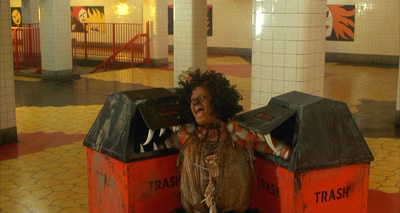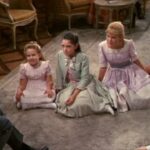*/**** Image B Sound B+ (DTS) B- (DD) Extras C-
starring Diana Ross, Michael Jackson, Nipsey Russell, Richard Pryor
screenplay by Joel Schumacher
directed by Sidney Lumet
 by Alex Jackson The Wizard of Oz is a quintessentially American work that could not possibly have been produced by any other culture. Doing a “blaxploitation” version of the story, then, seems considerably less tacky than doing one of Dracula or Frankenstein. Dorothy is a farm girl from Kansas living with extended family in something beyond the traditional nuclear-family structure. There’s a strong sense of community in the film as well: in addition to Auntie Em, Uncle Henry, and the hired hands, Professor Marvel, the inspiration for the Wizard of Oz, is there at Dorothy’s bedside when she wakes up. Dealing with themes of solidarity among the working class, The Wizard of Oz isn’t a film about the black experience, but with just a little tinkering, it easily could be.
by Alex Jackson The Wizard of Oz is a quintessentially American work that could not possibly have been produced by any other culture. Doing a “blaxploitation” version of the story, then, seems considerably less tacky than doing one of Dracula or Frankenstein. Dorothy is a farm girl from Kansas living with extended family in something beyond the traditional nuclear-family structure. There’s a strong sense of community in the film as well: in addition to Auntie Em, Uncle Henry, and the hired hands, Professor Marvel, the inspiration for the Wizard of Oz, is there at Dorothy’s bedside when she wakes up. Dealing with themes of solidarity among the working class, The Wizard of Oz isn’t a film about the black experience, but with just a little tinkering, it easily could be.
I’m usually uneasy discussing issues of racial identity, since the parameters are so vaguely defined. What exactly should a “black” version of The Wizard of Oz look like, anyway? And if it were done successfully, how would I know? If I have anything nice to say about Hollywood’s answer to the first question, 1978’s The Wiz, it’s that it manages to strike a delicate balance between caricaturing and mere tokenism. It’s an awful film, atrocious even, but I have to admit that it isn’t offensive. I never felt particularly embarrassed for the performers–outside of the normal embarrassment one feels for anybody stuck in a bad movie, that is.
No, the biggest problem with The Wiz is that it was made by people who don’t particularly like, much less understand, The Wizard of Oz. Director Sidney Lumet and screenwriter Joel Schumacher (who reportedly used none of William F. Brown’s stage script) aren’t content to simply provide an ethnic variant of The Wizard of Oz–they want to completely replace it. The result is the kind of remake that gives remakes such a bad reputation. By updating The Wizard of Oz for the Seventies, Lumet and Schumacher have transformed a timeless classic into dated kitsch.
Dorothy (Diana Ross) is a Harlem-area kindergarten teacher. She’s 24 but still lives with her Auntie Em (Theresa Merrit) and Uncle Henry (Stanley Greene). After Thanksgiving one year, Auntie Em tells Dorothy that she ought to get married and settle down. She recommends that Dorothy go and teach high school: it’s better money, plus she’ll be around students closer to her own age. (Not quite Debra LaFave material, but a little pervy, don’t you think?) Dorothy says that she’s happy teaching little kids and doesn’t see any reason to journey south of 125th street. In other words, the lesson of The Wizard of Oz is ultimately inverted: instead of learning not to journey outside her own backyard, Dorothy will presumably learn she has to leave home sooner or later or else life will pass her by.
Of all the film’s alterations to The Wizard of Oz, this strikes me as the most drastic. It’s the height of naïveté and arrogance to think you can or should “fix” The Wizard of Oz. The film’s regressive message is precisely what gives it a little bit of a subversive kick. (Look, for example, at how Martin Scorsese’s After Hours and Stanley Kubrick’s Eyes Wide Shut turned this “No place like home” moral on its head.) Lumet and Schumacher have apparently decided that what happens to Dorothy, what she takes away from her experience, isn’t a message they can get behind. Lacking the insight to treat it ironically, they subject The Wizard of Oz‘s entire value system to revisionism.
“No place like home” is the very foundation of The Wizard of Oz. Change this, and the film loses anything remotely resembling a raison d’être. If Dorothy is supposed to overcome her irrational fear of the territory outside her safe haven, why have her whisked away to Oz, where she is clearly in mortal danger? In the original film, this served as a wish-fulfillment device to show Dorothy that home really is the place to be. What does it mean to go off to Oz here? And why does the film end with her leaving Oz? Wouldn’t it illustrate the point that she needs to leave home better if she didn’t return to it?
The film attempts to support its thesis by comparing Dorothy to The Wiz (Richard Pryor), a failed politician who landed in Oz in his hot air balloon and was immediately hailed as a great wizard. He’s terrified that people will figure out that he’s a fraud, thus he’s never left his room at the Emerald City palace. Dorothy shows that the Scarecrow (Michael Jackson) had a brain, the Tin Man (Nipsey Russell) had a heart, and the Cowardly Lion (Ted Ross) had courage all along, whereupon The Wiz asks her to help him. Dorothy responds that she only knows he’ll never find what he’s looking for in a cocoon. There’s a whole world out there, and he needs to start by letting people see who he is. I simply don’t buy this. The film retains the idea that you can get everything you need from within and in an early scene rather explicitly argues that you shouldn’t let others define who you are; the solipsism of The Wizard of Oz stems directly from its credo that there’s “no place like home.” By reversing the philosophical backbone of The Wizard of Oz, The Wiz‘s declarations that you “just need to believe in yourself” ring hollow.
***
Apparently, in the original stage production of The Wiz, the Wiz gifts each of the characters with a token of the personality traits they were searching for in an echo of the classic film. The Scarecrow receives some bran sprinkles dubbed “all brain,” the Tin Man a red satin heart, and the Lion a chalice full of whiskey–liquid courage! This last one is particularly interesting, not only for being audaciously politically incorrect, but also for paralleling the irreverence of The Wizard of Oz with that of American Negro folklore circa the late 19th and early 20th century.
Determined to send a positive message, specifically for children of colour, Lumet’s sickeningly wholesome The Wiz doesn’t do anything of the sort. The Scarecrow, the Tin Man, and the Cowardly Lion all represent self-destructive African-American identities. The Scarecrow is told that he’s stupid and believes it. His only friends are some jeering crows who belittle his attempts to educate himself. The Tin Man is a sort of gigolo–a mechanized stud who hasn’t the capacity for sexual intimacy. The Cowardly Lion represents black pride perverted into militancy, though the Lion’s introduction is the only one that doesn’t employ any racist iconography. (A gang of jive-talking crows keeps the Scarecrow captive, of course, and the Tin Man is crushed under a giant lawn jockey.) The implication is that the Lion’s rage is particularly inauthentic, as it is not born directly of racial injustice.
The Wiz himself evidently symbolizes the emptiness of an American Dream based on consumerism and material wealth. In an introductory musical number, he keeps changing the colours that are in fashion at the moment. The film’s “Wicked Witch” character, Evillene (Mabel King), runs a sweatshop, and our heroes must destroy her in order to please The Wiz. I think what the film is getting at is that social mobility as defined in capitalist America consists of becoming the oppressor as opposed to the oppressed. Instead of working in the sweatshop, you aspire to own the sweatshop. To follow the path of The Wiz and the “yellow brick road,” Dorothy and co. must overthrow Evillene and take her place.
As you might have guessed, I’m not particularly impressed with the film’s anti-capitalist message. It’s not that I’m cheering for The Man, exactly, but I do feel that Lumet and Schumacher, thinking they’ve found an easy target to score points off of, have inadvertently stumbled upon a socio-political dilemma far too complex and substantial to be solved with banalities like “Believe in yourself.” I do wonder what would happen if The Wiz were white. It wouldn’t make the movie any better (indeed, it would seem even more moralistic and divisive in a nasty way), but at least the lesson of seeking the solution within rather than from external institutions would have a certain logic to it.
The Wiz deviates from the stage production in two other significant ways: 1. Dorothy, formerly a 12 or 13-year-old girl, is now 23 and played by the 33-year-old singer Diana Ross; 2. The play took place in Kansas, whereas the film takes place in Harlem, with Oz serving as a “dream-like” version of New York. Both changes were for the worse. Ross isn’t a terrible actress, but she’s unable to convincingly age a part originally written for a child. The more she cries and sings about going back home, the more we want to slap her and tell her to grow up. The passivity that is relatively normal in a ‘tween-age girl comes off as repulsive in an adult woman. As for the New York setting, well, considering the ramifications of the film’s ideological reversal, I probably shouldn’t be surprised that the lack of contrast between Oz and Harlem neutralizes the dreamy fantasy that’s part of the appeal of The Wizard of Oz. Too, there is something in Lumet’s eye that renders New York inherently dirty and dangerous. A few tight shots of Dorothy pursuing Toto down a stairwell intuitively reminded me of Lumet’s Serpico, and I half expected Dorothy to be gang-raped on the other side. Come to think of it, perhaps a disassociating disorder explains why Oz is just a “magical” version of Harlem.
THE DVD
Universal’s “30th Anniversary Edition” of The Wiz sports a digitally remastered transfer and a new 5.1 remix (the previous DVD only had four channels). The 1.88:1 anamorphic widescreen presentation is dim and grainy but exhibits no significant print damage or digital artifacts. The 5.1 audio comes in Dolby Digital and (superior) DTS flavours: Where the former sounds distant, the latter sounds present; stereo imaging is equally strong during the songs but more transparent and less gimmicky in DTS. That said, neither track truly delivers a 360° soundfield. Extras are recycled from the 1999 release, a bonus soundtrack CD the notable exception. (Thanks, but no thanks.) The unfortunately-titled “Wiz on Down the Road” (12 mins.) is a vintage making-of featurette detailing how Ross came to be cast as Dorothy and how Lumet came aboard as director. Lumet, who has apparently disowned the film, is shown here deeply involved in every aspect of the production, particularly in the disastrous decision to move the story to New York. The film’s theatrical trailer rounds out the platter.
135 minutes; G; 1.88:1 (16×9-enhanced); English DD 5.1, English DTS 5.1, French DD 2.0 (Mono); English SDH, French subtitles; Region One; DVD-9 + CD; Universal






![The Verdict (1982) [Collector's Edition] - DVD The Verdict (1982) [Collector's Edition] - DVD](https://filmfreakcentral.net/wp-content/plugins/contextual-related-posts/default.png)